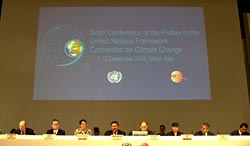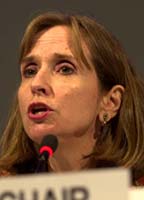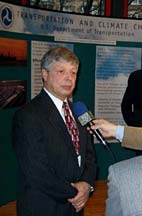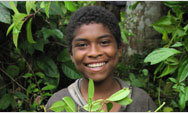FrontLines: Foreign Aid Addresses Climate Change
January 2004
  |
| Opening Plenary of COP-9, Milan, Italy (2003) |
  |
| High level Roundtable at COP-9 co-chaired by Undersecretary
Paula Dobriansky, U.S. Department of State. |
Helping developing countries cut green-house emissions with new technologies and improve their
ability to adapt to climate change is a critical part of U.S. efforts to address global climate
change. In FY 2004, USAID’s climate change budget reached $180 million.
Many developing countries are likely to experience climate change effects such as drought, rising
sea levels, epidemics, and dying coral reefs.
In December 2003, the U.S. government sent an interagency delegation that included senior
representatives from USAID’s Bureau for Economic Growth, Agriculture, and Trade (EGAT) to
the annual meeting of the U.N. Framework Convention on Climate Change (UNFCCC) in Milan, Italy.
Currently, 188 countries are parties to the UNFCCC, adopted in 1994, whose goal is to stabilize
greenhouse gas concentrations at levels that won’t upset the earth’s climate system and
threaten its inhabitants.
  |
| Paula Dobriansky, Undersecretary for Global Affairs,
U.S. Department of State at COP-9, Italy (2003). |
Delegates discussed how to implement the Kyoto Protocol, which, if ratified, would require
signatories to reduce emissions by at least 5 percent by 2012. The protocol will go into effect
once it is ratified by 55 countries that account for 55 percent of global warming emissions.
The United States does not support the Kyoto Protocol for a variety of reasons, but participated
in the discussions to ensure U.S. interests were addressed.
Under Secretary of State Paula Dobriansky, the U.S. delegation leader, said governments should work
together with the private sector to transfer technology to help developing countries reduce emissions.
“International technology partnerships are an example of cooperation that is tailored to meet
technology goal, such as the transition to the hydrogen economy,” said Dobriansky.
U.S. foreign aid for global climate change is funded primarily through USAID.
  |
| Dr. Harlan Watson, US State Department, at COP-9. |
A six-person EGAT climate change team, led by Ko Barrett, helps missions carry out climate change
activities in more than 40 countries.
The goal is to reduce the growth of greenhouse gas emissions, increase “carbon sinks”
(such as forests that absorb carbon emissions), and facilitate participation of developing countries
in UNFCCC. Recently, adaptation to climate change was added to the program’s portfolio.
Key ways USAID is involved in climate change include:
- Improving energy efficiency, using renewable energy such as hydropower, or
publicizing clean energy technologies so the private sector can adopt them.
- Promoting carbon sequestration (trap-ping carbon in trees and plant life)
through reforestation, forest conservation, and ending poor agricultural practices such as
burning fields; these actions help keep carbon out of the air.
- Setting up an office to serve as a focal point on climate change issues—such
as the one USAID helped the Ukrainian government establish—or helping draw up an inventory
of emissions and energy and land use, as USAID and the Environmental Protection Agency are doing
in Central America.
- Studying and anticipating changes that alter temperature and precipitation.
These affect USAID programs, especially those relating to water and agriculture.
Access the January 2004 edition of FrontLines.
Back to Top ^
|


